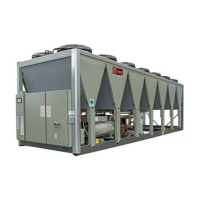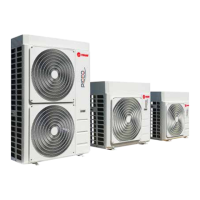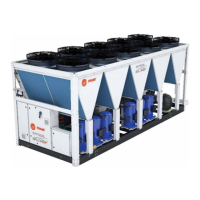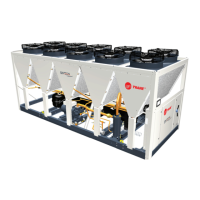CTV-PRB004-EN 31
Medium-Voltage StarterTypes (2,300–6,600 Volts)
Table 7 shows the most common medium-voltage starter types available and compares inrush
current, torque, frequency of use, advantages and disadvantages, and typical acceleration time.
The inrush profiles are shown in Figure 22.
Which starter type is best?
One question often asked is: “Which is better, full voltage or reduced voltage?” Because medium-
voltage starters by nature use less current than low voltage, and therefore have significantly less
current inrush. Across-the-line medium-voltage starters are more commonly used; however, in
certain applications reduced voltage will be used to minimize starting strain on the electrical
system.
Unit- or remote-mounted?
Unit-mounted medium-voltage starters can save on installed cost and space.They are tested in the
factory and are shipped on the chiller. Remote-mounted starters are sometimes bussed together
in various configurations as shown in “Multiple Starter Lineups (2,300–6,600 volts),” p. 61. Remote-
mounted starters fromTrane can have special NEMA options, whereas unit-mounted starters are
NEMA 1. All starters conform to ANSI/NEMA ICS-6 enclosure standards unless otherwise noted.
Table 7. Comparison of medium-voltage starters (2,300–6,600 volts)
Starter Type
(closed-transition)
Inrush
Current
% LRA
Percent
Rated
Torque
How
Often
Used Advantages Disadvantages
Typical
Acceleration
Time
(seconds)
Across-the-Line
(Full Voltage)
100 100 27%
• Low cost
• Least complex
• Least maintenance
• Draws highest inrush current
at startup
3–5
Primary Reactor
65% TAP
65 42 49%
• Good compromise between
first cost and inrush current
reduction
• More expensive than Across-
the-Line
• Larger than Across-the-Line
5–12
Autotransformer
65% TAP
45 42 22%
• Almost equal reduction of
torque and inrush current
• Lowest inrush current
• Most expensive
• Larger than Across-the-Line
5–12
AFD
<13
(<RLA)
Varies 2%
• Efficiency at part lift
• Power factor
• Very expensive
• Large and heavy
• Complex
5–12
Figure 22. Comparison of medium-voltage starting current
Across-the-Line
Autotransformer (65% tap)
01
2345678910
Time (seconds)
0
20
40
60
80
100
120
% LRA
Primary Reactor (65% tap)
AFD
CTV-PRB004.book Page 31 Sunday, December 18, 2011 6:39 PM
